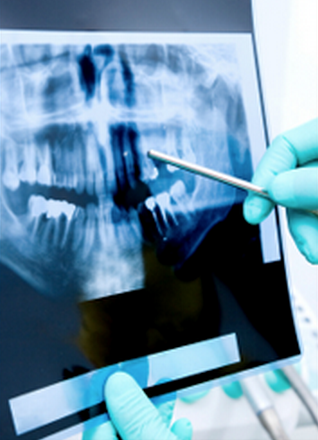Diagnostic records are a vital part of developing an appropriate treatment plan. With these diagnostic records, your orthodontist can view x-rays, photos and images of your teeth to determine the position of your teeth as well as the position and relationship of the jaw and teeth.
X-Rays
We utilize digital radiographs, or X-rays, in our office. These radiographs provide us with invaluable information about your oral and dental health.
While radiographic equipment does produce radiation (and depends on that radiation to function properly), modern advances in technology are continually reducing the amount of radiation that is produced. In fact, studies have shown that the amount of radiation produced by these machines is not significantly higher than other “normal” sources of radiation that we are exposed to on perhaps a daily basis, such as televisions and airplanes.
X-rays work on a simple principle: the X-rays are stimulated and sent through the mouth. When these rays pass through, they are absorbed more by the bones in your mouth than the gums and other soft tissues, creating a picture of how the teeth inside your mouth are positioned.
C Mound Models
Our office uses digital models to help create the smile you want. Digital modeling allows us to create a three-dimensional digital model of your teeth, which help us keep you informed of your treatment options and progress, while also providing you with optimal results. After we create a personalized treatment plan that meets your specific needs and desires, digital models allow us to create customized bracket trays that lets us place your brackets all at one time, with increased efficiency and overall effectiveness.
Some benefits of digital models over traditional study model materials include:
- Accuracy: they require fewer appointments.
- Efficiency: they require less time in the treatment chair.
- Customizability: they provide a digital plan and allow for trays that are tailored to meet the individual needs and desires of each patient.
- Visualization: they provide each patient with a definite picture of what their teeth will look like following treatment.
- Innovation: they use the most advanced 3-D video technologies.

Photo Series
We are proud to utilize the latest technology available to ensure our patients enjoy the best results. We use high-resolution digital photography to capture a photo series with detailed images of your mouth, thus enabling us to maintain sharp, accurate records and keep you thoroughly informed of your treatment progress.
ReSaive Series – Photos
We are currently gathering resources for this page. Please check back soon for more information!
CBCT Imaging
While CT (computed tomography) imaging has been used in the medical field for over 30 years, it is becoming the new diagnostic tool of choice for orthodontic analysis, diagnosis and treatment planning due to the latest advancements in diagnostic technology such as the revolutionary Cone Beam 3-D Imaging System. This three-dimensional CT technology can provide a quicker full scan of the head than traditional two-dimensional imaging, allowing orthodontists a better visualization of the hard and soft tissues of the craniofacial structures from several perspectives. In addition to the advantages of traditional CT scans, Cone Beam releases up to 90% less radiation than traditional X-ray machines, enhancing your safety while providing crisp, clear images for more efficient diagnostic analysis and treatment. We feel our modern, cutting-edge techniques ensure you are receiving the quality care you deserve.
The Cone Beam 3-D Imaging System can immediately produce three-dimensional images in under one minute. This in-office, easy-to-use system provides your orthodontist a comprehensive view of all oral and maxillofacial structures, dramatically increasing the efficiency with which your orthodontist is able diagnose your condition and plan for your treatment.
Cone Beam CT technology is used for:
- TMJ assessment
- Surgical planning
- Assessment of cleft lip and palates
- Assessment of the alveolar bone
- Impacted tooth position
- Facial analysis
- Tongue size and posture
- Airway assessment
- Placement of dental implants


